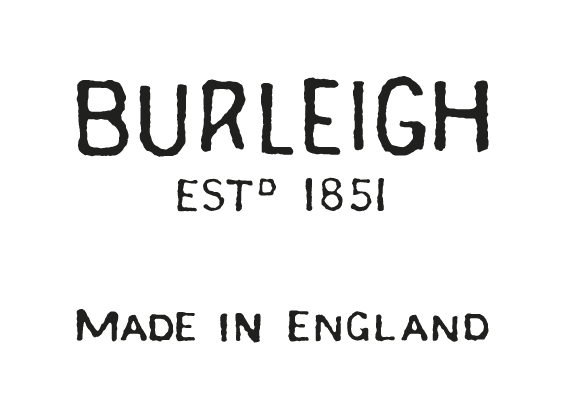The Asiatic Pheasants collection is a true icon of English tableware with huge popularity spanning the last 190 years and it remains in production today; available in shades of Blue, and Pink.

The pattern was originally designed in Staffordshire in the 1830's by whom was believed to be a self-employed engraver. Companies produced designs which could then be purchased as engraved plates; multiple factories could produce the same pattern, and it was common practice that no manufacturer's mark or backstamp would be applied to the underside. As businesses opened and closed in this volatile industry, engravings would change hands frequently so attributing a pattern to a designer during these times was impossible.
Out of hundreds of patterns created during this period to meet the growing demands around the globe, this one certainly caught on. In the earlier 1800's consumer preference had been for a more heavily decorated design, in the 1830's Asiatic Pheasants was part of a shift towards something more delicate, with greater amounts of open pattern. Alongside the change is designs at the time, also came a change in colour, with softer and lighter colours becoming available.
At least 60 known manufacturers have produced this iconic pattern Asiatic Pheasants over the years, and it is widely accepted that our founders’ (William Leigh) former employer was the first factory to produce the pattern. As the years have passed this number has dwindled and by 2000, Burgess & Leigh Ltd became the last home of Asiatic Pheasants, where it continued to be produced in the original manner using underglaze transfer printing.
Over the years since these early days of production Pink Asiatic Pheasants has been reintroduced several times, remaining in continuous production for the last twenty years where we are dedicated to using traditional skills and techniques to produce our infamous ware, the highest-quality raw materials and our dedicated team of craftspeople each create our classic and timeless tableware, just like we did 170 years ago. The last Pottery of our kind in many respects, Burleigh bears a binding commitment to tradition and craftsmanship; demonstrating true charm in each and every piece of ware.
We continue look to the way our founders embraced modernity to improve factory conditions and workflow and hold ourselves to that standard. We embrace technology where necessary in the production process, and by combining our unique decorating technique with new and reimagined designs from our archive to reflect the changing relationships society has with ceramic ware.
Following our 170th anniversary, there is no change in these processes and this year saw us introduce a brand new roller to our growing collection, for none other than Pink Asiatic Pheasants. This forms part of the ongoing cycle of replacements, as our rollers only have a certain lifespan before they become too worn to function in production. Zoe, part of the design team at Burleigh Pottery, worked tirelessly to replicate the pattern exactly.
Each of our Burleigh patterns are produced from engraved copper rollers. Some of our patterns, like Blue Calico, only require one roller to produce any variety of shapes due to the skilled wrapping of our team of decorators; we call these patterns ‘sheet’ patterns. Some of our patterns however have exactly fitting boarders and embellishments which mean multiple engraved rollers are needed to produce the elements to decorate a large range of shapes; we call these ‘border’ patterns. Asiatic Pheasants is one of these border patterns and has needed four rollers to produce our current range of shapes.
Our rollers last for upwards of 20 years in production, depending on the frequency of use. In this time, they produce hundreds of thousands of pieces. Eventually, there comes a time when our rollers no longer meet high quality standards and have to be retired from production. In late 2019 we noticed the initial signs of wear on our Asiatic Pheasants Teacup and Teapot roller and planned for their retirement. Both rollers had been in production for over twenty years and produced approximately 600,000 pieces during their lifespan.
The first stage in this plan was to take clear prints of both rollers to preserve all the intricate detail within the patterns. Both prints were then scanned and marks from use were digitally cleaned away. This is a meticulous operation, in which the original rollers are continuously referred to through magnifying glasses, alongside the other rollers in the range to ensure we are exactly replicating the original engraving. Our engraved rollers are created through a combination of line and dot work which give Burleigh ware its distinctive tonal quality. The team work at a very close scale digitally and look at the roller painstakingly dot by dot, to ensure the weight and style of this mark-making holds this unique quality. This takes several months and is a very skilled process. Once the designs were digitally captured, the motifs from both the ‘Teacup’ and ‘Teapot’ roller were then combined to form the artwork for the new ‘Teacup/Teapot’ roller.
The digital file is then used to engrave a new copper roller, which we then have to trial within the factory to ensure it is a match to it’s predecessors.
Zoe Shaw, Development Technician; “the satisfaction of seeing the new Asiatic Pheasants roller come into production is incredible, seeing the transition from pixels on a screen to a beautiful chromed cylinder, and then into print. The first prints done from a new roller are nerve-racking to say the least, seeing the culmination of months of work resolved in a few print, however after seeing the first print these worries are transformed into wonder at the process and knowing it will be used in production for many years to come”.
Now our new ‘Teacup/Teapot’ roller is in full production, we have safely archived our ‘Teacup’ and ‘Teapot’ rollers, preserving that piece of our story for the future.




